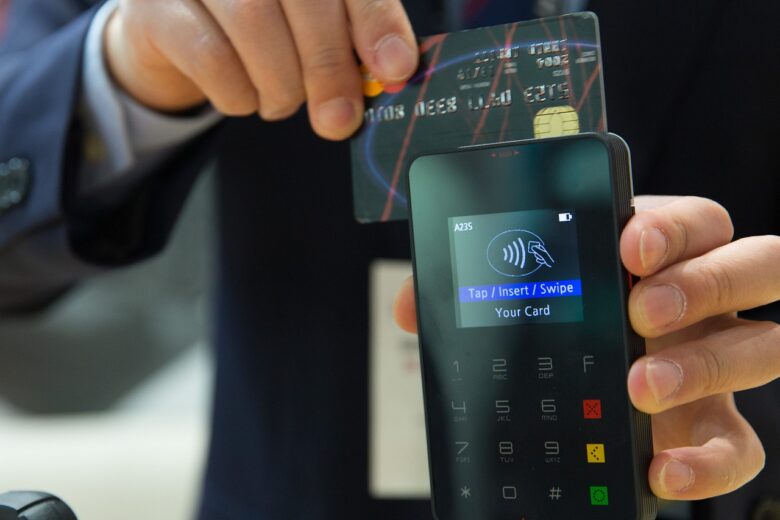Accepting card payments is essential for businesses in today’s economy. Credit card usage is widespread, with millions of transactions occurring daily.
For small businesses, offering card payment options can lead to significant benefits, including increased sales and customer satisfaction.
Let me share what every business should know about it.
Types of Card Payments
First, let talk about the types of card payments.
Swiped Transactions (Magnetic Stripe)

Source: hostmerchantservices.com
Swiped transactions involve reading the magnetic stripe on a card by swiping it through a terminal. This method transmits card data to the payment processor. Despite being less secure due to susceptibility to skimming, it remains common.
The data captured includes the card number, expiration date, and cardholder name. Security for swiped transactions relies heavily on the encryption and secure transmission protocols to prevent unauthorized access.
Dipped Transactions (EMV Chip Cards)
Dipped transactions utilize EMV chip technology, where the card is inserted into a reader. This method enhances security by generating a unique transaction code for each use, making it difficult to clone.
The data transmission involves more complex encryption compared to magnetic stripes. EMV chips significantly reduce fraud risk, providing an added layer of protection for both businesses and customers.
Tapped Transactions (Contactless)
Contactless transactions involve tapping a card or a device on a reader. Utilizing Near Field Communication (NFC) technology, these transactions are swift and convenient. Data transmission is encrypted, ensuring secure processing.
The primary benefit is the speed and ease of use, particularly beneficial for high-volume, fast-paced environments. The security measures are robust, involving tokenization and dynamic data for each transaction.
Digital Wallet Transactions

Source: adyen.com
Digital wallets store payment information digitally, allowing transactions via mobile phones or other devices. Transactions are authenticated through biometric methods like fingerprint or facial recognition, adding a security layer.
The transmission process involves tokenization, which replaces sensitive information with unique identifiers. Digital wallets are gaining popularity due to their convenience and enhanced security features.
Online and Card-Not-Present (CNP) Transactions
Online transactions occur without the physical presence of a card, posing higher fraud risks. Security measures include CVV verification, address verification, and secure sockets layer (SSL) encryption.
These transactions are crucial for e-commerce, allowing businesses to reach a global customer base. Enhanced security protocols, such as 3D Secure, help mitigate risks associated with CNP transactions.
Benefits of Accepting Credit Card Payments

Source: google.com
Now let us talk about the benefits of accepting this sort of payment.
Increased Sales and Customer Base
When you accept card payments on phone that can lead to higher sales by accommodating more customers who prefer using cards over cash. Customers tend to spend more when paying with credit cards, boosting average transaction values.
Competitive Edge in the Market
Offering card payments gives businesses a competitive advantage. It caters to customer preferences and expectations, making it easier for them to choose your business over competitors who might not offer card payment options.
Improved Record-Keeping and Accounting
Card payments facilitate better record-keeping and accounting. Transactions are automatically recorded, reducing errors and making it easier to track sales, manage inventory, and prepare financial reports.
Enhanced Brand Image and Professionalism
Accepting card payments can enhance a business’s brand image, portraying it as modern and customer-friendly. It reflects professionalism and reliability, important factors in building customer trust and loyalty.
Better Customer Experience and Loyalty
Card payments offer convenience and speed, enhancing the overall customer experience. Satisfied customers are more likely to return and become loyal patrons. Loyalty programs linked to card payments can further encourage repeat business.
Steps to Accepting Card Payments

Before you decide to accept card payments, you must be aware of the steps needed to undertake before this becomes a reality.
Choosing a Payment Services Provider (PSP)
Selecting the right PSP is crucial. Consider factors such as market trends, technical support, customization options, and scalability to meet your business’s current and future needs. Research and compare different providers to find the best fit.
Negotiating Terms and Fees
Understanding and negotiating terms and fees with your PSP can significantly impact your costs. Look into transaction fees, monthly fees, and any additional charges. Aim for a balance between affordability and the quality of service provided.
Setting Up a Merchant Account
A merchant account is essential for processing card payments. Ensure that your business model aligns with the account’s requirements. Prepare necessary documentation and understand the factors affecting approval, such as credit history and business type.
Integrating a Payment Gateway
A payment gateway securely processes transactions between your business and the payment processor. Consider security features, ease of integration, and the benefits of a unified commerce system that combines in-person and online transactions.
Acquiring Hardware and Software for In-Person Transactions
Invest in reliable hardware and software for processing in-person transactions. Consider compatibility with your existing systems, future-proofing capabilities, and ongoing support. A seamless integration ensures a smooth transaction process for customers.
How Credit Card Processing Works

Source: alliedwallet.com
The process starts when a customer initiates a transaction by swiping, dipping, tapping, or entering card details online. The payment terminal or gateway captures and encrypts the card information.
The payment processor sends the encrypted information to the issuing bank for authorization. The bank verifies the card details, checks for sufficient funds or credit, and either approves or declines the transaction.
Approved transactions are grouped into batches, typically at the end of the business day. This batch is sent to the payment processor for clearing and settlement.
The payment processor forwards the batch to the card networks (e.g., Visa, MasterCard) for clearing. The networks transfer the funds from the issuing banks to the acquiring bank, which then deposits the funds into the merchant’s account.
Various fees are involved in credit card processing, including interchange fees, assessment fees, and processor markup. These charges vary depending on the transaction type, card type, and negotiated terms with the PSP.
Compliance with standards like PCI-DSS (Payment Card Industry Data Security Standard) is mandatory. Implementing robust security measures, such as encryption, tokenization, and fraud detection tools, helps protect sensitive data and reduce fraud risks.
The Bottom Line
Accepting card payments is essential for business growth and customer satisfaction. Integrating card payment systems can significantly benefit businesses, enhancing efficiency, security, and customer experience.




